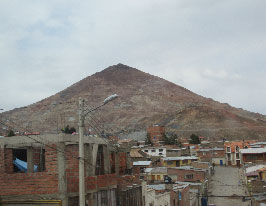07 – Cerro Rico – A unique mineral and metal ore mountain – Potosi / Bolivia
Ano 04 (2017) - Número 01 Artigos
![]() 10.31419/ISSN.2594-942X.v42017i1a7HP
10.31419/ISSN.2594-942X.v42017i1a7HP
Herbert Poellmann, Prof. Dr.Dr. Institute of Geosciences and Geography, Martin Luther University Halle-Wittenberg, Halle (Saale), Germany.
Cerro Rico is a mountain close to the old colonial town of Potosi (founded in 1545) which is famous since the 16th century. The elevation of Potosi is 4067 m above sea level, Cerro Rico is about 4800 m (Figure 1). Potosi was one of the world famous towns due to the tremendous occurences of silver producing more than 50% of the worlds silver production at that time (Figure 2). The population of about 160.000 inhabitants in 1600 was similar to the population of Amsterdam or London at that time. Nowadays the mines still produce zinc, tin tungsten, lead, copper and silver. The Cerro Rico magmatic dome ores are enriched in different veins in quartz porphyric rocks breccias and tuffs and is part of the central Andean tin belt. Therefore it is a vein hosted polymetallic deposit. Silver is enriched in the upper part of the deposit and tin is mainly occuring in the lower part. It is described, that more than 60.000 t of silver and 100.000 t of tin were produced. Cerro Rico contains many different minerals and is type locality for 2 new tin sulfide minerals (ottemannite – Sn2S3 and berndtite – SnS2). The spanish king Charles V stated „I am rich Potosi“ to document the richness produced in Potosi at that time.
A summary of the most important minerals are given in www.mindat.org/loc-325.html. Besides the typical ore minerals expecially from all minerals probably the best crystals of slightly green phosphophyllite, (Zn2Fe(PO4)2.4H2O), were found there. A literature about the Potosi mine es describe too.
LITERATURE
AHLFELD,F.: The bolivian tin belt, Econ. Geol. 31, 48-72, (1935)
CUNNINGHAM, C.G., ZARTMAN, R.E., MCKEE, E.H., RYE, R.O., NAESER, C.W., SANJINÉS V., O., ERICKSEN, G.E., AND TAVERA V., F., 1996, The age and thermal history of Cerro Rico de Potosí, Bolivia: Mineralium Deposita, v. 31, p. 374–385.
DIE CERRO RICO MINEN IN POTOSI (BOLIVIEN), Ernst Klett Verlag, Stuttgart, 1971
FERRY, S.: I AM RICH POTOSI,- The mountain that eats men, The Montcelli Press , New York , 1999
HYRSL,J. & PETZROV,A.: Bolivia, the height of mineral collecting, LLC, Denver Colorado
LINDGREN, W. & CREVELING, J.G.: The ore deposits of Potosi, Bolivia, Econom. Geol. 23, 233.-262, (1928)
RECHENBERG, H.P.: Gangtektonik und Störungen im Cerro Rico de Potosi, Bolivien, N.Jb.Geol.& Pal., Abh. 101, 1-11, (1955)
RICE,C.M., STEELE,G.B., BARFORD,D.N., BOYCE,A.J. & PRINGEL,M.S.: Duration of magmatic, hydrothermal and supergene activity at Cerro Rico de Potosi, Bolivia, Economic Geology 100, 8, 1647-1656, (2005)
SILLITOE, R.H., STEELE, G.B., THOMPSON, J.F.H., AND LANG, J.R. (1998): Advanced argillic lithocaps in the Bolivian tin-silver belt. Mineralium Deposita 33, 539-546
SILLITOE, R.H., HALLS, C., AND GRANT, J.N.: Porphyry tin deposits in Bolivia: Economic Geol., 70, p. 913–927, 1975
TURNEAURE, F.S.: The bolivian tin silver province, Econ. Geol. 66, 215-225, (1971)
WILSON,W. & PETROV, A.: Cerro Rico de Potosi, Bolivia, 9-35, Min.Rec. 30, 1,2, (1999)
WENIGER, H.: Ein bemerkenswerter Phosphophyllitkristall von Cerro Rico/Potosi, Der Aufschluß 25, 525
Cerro de Potosi (Cerro Rico) www.mindat.org/loc-325.html


